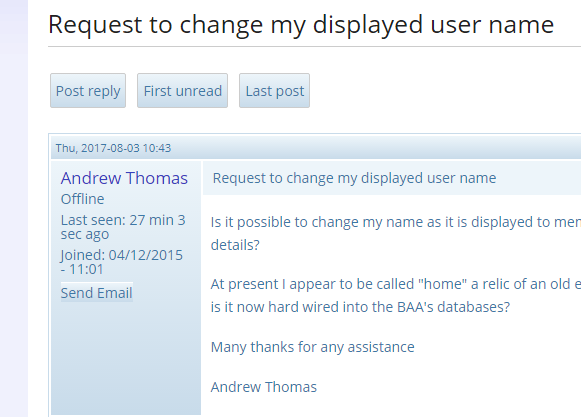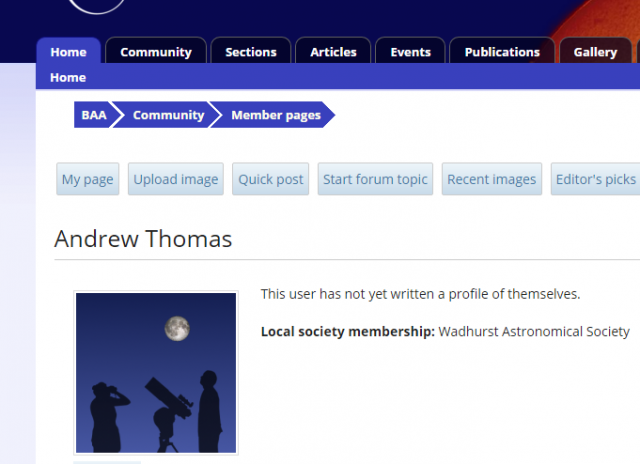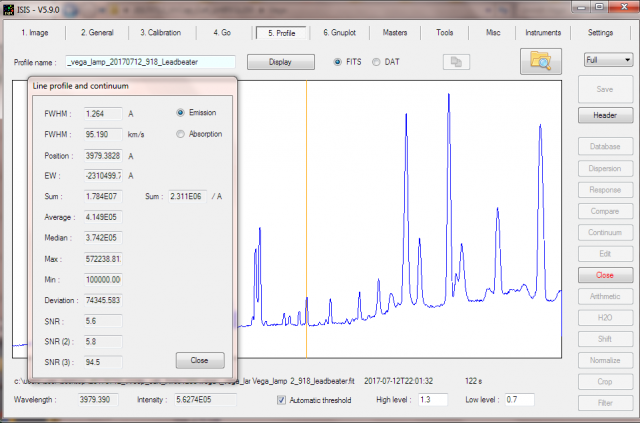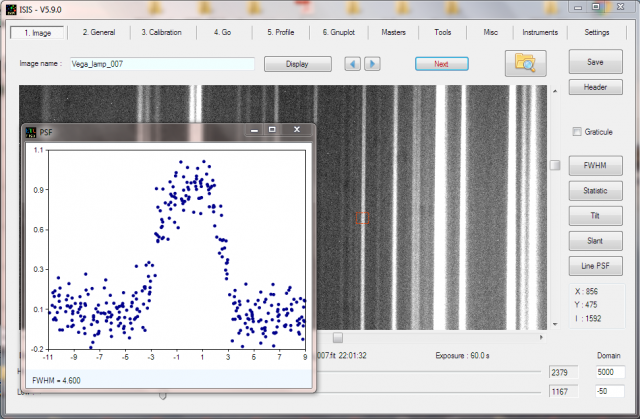Forum Replies Created
-
AuthorPosts
-
 Robin LeadbeaterParticipant
Robin LeadbeaterParticipantHi Nick,
I’ll have a try at extracting it from the background. I don’t understand where all the emission lines in the sky background come from though. They do not look like galactic lines to me. Do they have an unusual light pollution problem or something or perhaps they superimpose the calibration lamp spectrum?
Robin
EDIT: ok the “emission lines” are actually severe fringing in the IR. I can see the O2 telluric band so should be able to cross check the wavelength calibration.
 Robin LeadbeaterParticipant
Robin LeadbeaterParticipantHi Nick,
The author of the article,Francois Teyssier is the resident expert amateur on CV spectroscopy in the ARAS group. He publishes a nominally monthly newsletter on the group’s activities in this area.
http://www.astrosurf.com/aras/novae/InformationLetter/InformationLetter.html
There have been a number of nova confirmations by amateurs recently and followup up spectra tracking the evolution of some targets. We have been getting a lot of support interpreting the data from professional Steve Shore.
I expect the FLOYDS spectrum should settle the matter. It is a rather strange low resolution 2 order echelle instrument though which needs a very specific data reduction pipeline. (looking at the spectrum image, subtracting the sky background should be an interesting challenge !)
Cheers
Robin
 Robin LeadbeaterParticipant
Robin LeadbeaterParticipantGood to hear. mag 16 makes it well within range, possibly with other observers too. I will put out an alert on the ARAS forum
Robin
 Robin LeadbeaterParticipant
Robin LeadbeaterParticipantHi Nick
In good conditions, mag 17 is just within range at very low resolution (R~130) with my modified ALPY 200 and I don’t know anyone operating fainter currently but the contrast against the galactic background does not look high based on your image so it could be very tough. I have noted it to have a look but no promises, particularly as there are no clear skies forecast here for the week ahead currently
Cheers
Robin
 Robin LeadbeaterParticipant
Robin LeadbeaterParticipantThanks Paul,
That’s 6 to date I think, though apart from taking a quick spectrum of the very bright sn2017eaw, I have not really been looking this year so this is the first in 2017. It looks like I have quite a bit more professional competition now though. For example ePESSTO now seems to be submitting half a dozen confirmations a night when it has telescope time.
I was planning to try for another one last night in ngc3172 (at2017gla) but it was so close to the pole (+89.1 deg Dec) that I was literally going round in circles trying to get the mount to point at it !
Cheers
Robin
 Robin LeadbeaterParticipant
Robin LeadbeaterParticipantHi Tony,
It will be interesting to see how your results compare with conventional differential photometry. It will give us an idea how accurate absolute flux calibration from a typical amateur observatory actually is. The difficulties compared with conventional differential photometry are you are dependent on stable atmospheric conditions and because suitable reference spectra calibrated in absolute flux are rather widely spaced, differential extinction has to be taken into account – the spectroscopic equivalent of all sky photometry.
Cheers
Robin
 Robin LeadbeaterParticipant
Robin LeadbeaterParticipantHi Jack,
I am not monitoring H alpha as the coverage there already looks pretty good.
I am just covering ~3800-4100 A (which covers H epsilon – H10 including Ca H,K ) This is the same region I monitored during the 2012-2013 eclipse of AZ Cas (A similar but much fainter system.)
http://www.threehillsobservatory.co.uk/astro/spectra_43.htm
The changes are very pronounced and potentially scientifically interesting in this region but I was the only one monitoring AZ Cas there. For VV Cep there are a couple of others working in that region though so hopefully we should get good coverage there for this eclipse.
Cheers
Robin
 Robin LeadbeaterParticipant
Robin LeadbeaterParticipantHello Jack,
I had not planned to do that. I just described how it could be done if you wanted to. I suggest you and Marc get together directly to make the comparison.
Cheers
Robin
 Robin LeadbeaterParticipant
Robin LeadbeaterParticipantHello Jack,
The fits spectrum profile I attached was just to show you how it can be done on the forum. The content is not important. It just happened to be a recent spectrum that I was working on.
Robin
 Robin LeadbeaterParticipant
Robin LeadbeaterParticipantHi Jack,
You have a lot of cosmetic defects (the narrow spikes caused by hot pixels.) This is quite surprising with such a bright target. Are your dark and hot pixel map corrections working OK?
Robin
 Robin LeadbeaterParticipant
Robin LeadbeaterParticipantJack said
“I am awaiting Robins response on this one.”
Hi Jack,
Not sure what this relates to. What do you want to know ?
 Robin LeadbeaterParticipant
Robin LeadbeaterParticipantHi Jack,
It is a fits spectrum profile to BeSS standard as used in the BAA database for example (Are you trying to open it as an image?) It will open in VSpec, ISIS, BASS etc. (change the extension from .fits back to .fit if you are having difficulties)
Cheers
Robin
 Robin LeadbeaterParticipant
Robin LeadbeaterParticipantHi Jack,
Spectrum profiles (in fits or dat format) are also small enough to be uploaded as attachments here if you need advice and are not ready to submit them to the database. For example here is my latest for VVCep at the blue end. It is a work in progress as I am not 100% happy yet with the instrument response/atmospheric extinction correction so I have not yet committed it to the database. (Note I had to change the extension from .fit to .fits as the forum does not accept .fit )
Robin
 Robin LeadbeaterParticipant
Robin LeadbeaterParticipantHi Andrew,
I see your name correctly in the forum and on your members page or am I not looking in the right place?
Robin


 Robin LeadbeaterParticipant
Robin LeadbeaterParticipantHi Jack
ISIS automatically estimates the resolving power from lamp line widths for you and adds it to the fits header (SPE-RPOW) or if you want to manually measure it (for example on different lines across the field) you can produce a spectrum profile using the lamp image and measure them directly using the FWHM function.

In ISIS you can even measure the width of the lines (in pixels) directly off the image using the PSF function – useful for checking if you have best focus.

Cheers
Robin
30 July 2017 at 11:44 pm in reply to: Keeler’s seminal paper on the spectroscopic observation of nebulae #578410 Robin LeadbeaterParticipant
Robin LeadbeaterParticipantFascinating. The description of the slanted lines in Jupiter’s spectrum due to rotation is familiar. It was one of the first things I looked at when I built my LHIRES III !
Ken Harrison recently pointed me to an on line version of another interesting historic document
“An Atlas of Representative Stellar Spectra 4870 to 3300” William Huggins published 1899
http://www.e-rara.ch/zut/content/titleinfo/15851436
An interesting parallel to Richard Walkers publication
Cheers
Robin
 Robin LeadbeaterParticipant
Robin LeadbeaterParticipantIt is interesting to estimate the net difference in flux between Marc’s and Jack’s setup. (A C11 with a 35um slit compared with a C14 with a 23um slit.) at 3 arcsec the slit throughput is 70% and 40% respectively but because of the higher collecting area of the C14 the difference in flux is reduced. The net effect is the total flux after the slit should be quite similar (Jack’s is ~5 % lower) Jack’s resolution will be ~50% higher though because of the narrower slit.
A good estimate of the actual resolution can be made from the FWHM of the internal calibration lamp lines.
Robin
 Robin LeadbeaterParticipant
Robin LeadbeaterParticipantHi Marc,
I am not sure where the throughput being proportional to the square of the slit width comes from. There are trade offs between slit width, SNR and resolution but the change in throughput with slit width depends on various factors. Ignoring diffraction effects, for an extended source the increase would be proportional to the slit width but with a stellar source it depends on the FWHM of the star image relative to the slit width. A good guide is to aim for a slit width equal to the star image FWHM. With a slit wider than that you are gaining little in throughput but losing resolution. If the slit is set narrower you will increasingly lose more throughput but you may prefer to take the resulting increase in resolution if you still have enough signal to still give the required SNR.
Regardless of the camera or gain, shorter exposures means fewer photons and thus higher shot noise (which dominates at high SNR). There is no free lunch here
Robin
 Robin LeadbeaterParticipant
Robin LeadbeaterParticipantThere is a nice calculator for this on the CAOS website
https://spectroscopy.wordpress.com/2009/05/22/slitpinhole-flux-calculator/#more-525
which I believe is incorporated in to Ken Harrison’s modified version of Christian Buil’s simspec, the spectrograph design spreadsheet. Plugging in the values for my setup (C11 at f10 and 3 arcsec seeing) it calculates 50% throughput at 23um, 70% throughput at 35um and 85% throughput at 50um slit width. I normally run a 35um slit.
Note that other variables such as guiding accuracy and position of the star on the slit can be as, if not more important though. The definitive test as to how much light you are using is to measure the flux of the spectrum of a star with and without the slit. (or in the narrow and wide parts of a photometric slit of you have one)
Cheers
Robin
27 July 2017 at 3:53 pm in reply to: Measuring radial velocity of planetary nebulae with Alpy? #578384 Robin LeadbeaterParticipant
Robin LeadbeaterParticipantImpressive RV precision ! There are various interesting physical properties that can be measured from spectra like this. Francois Teyssier has a worked example on his website
http://www.astronomie-amateur.fr/feuilles/Spectroscopie/NGC2392.html
Robin
-
AuthorPosts
